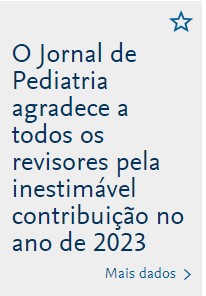To evaluate the efficacy and safety of nasal continuous positive airway pressure (NCPAP) using devices with variable flow or bubble continuous positive airway pressure (CPAP) regarding CPAP failure, presence of air leaks, total CPAP and oxygen time, and length of intensive care unit and hospital stay in neonates with moderate respiratory distress (RD) and birth weight (BW) > 1,500 g.
MethodsForty newborns requiring NCPAP were randomized into two study groups: variable flow group (VF) and continuous flow group (CF). The study was conducted between October 2008 and April 2010. Demographic data, CPAP failure, presence of air leaks, and total CPAP and oxygen time were recorded. Categorical outcomes were tested using the chi-square test or the Fisher’s exact test. Continuous variables were analyzed using the Mann-Whitney test. The level of significance was set at p < 0.05.
ResultsThere were no differences between the groups with regard to demographic data, CPAP failure (21.1 and 20.0% for VF and CF, respectively; p = 1.000), air leak syndrome (10.5 and 5.0%, respectively; p = 0.605), total CPAP time (median: 22.0 h, interquartile range [IQR]: 8.00-31.00 h and median: 22.0 h, IQR: 6.00-32.00 h, respectively; p = 0.822), and total oxygen time (median: 24.00 h, IQR: 7.00-85.00 h and median: 21.00 h, IQR: 9.50-66.75 h, respectively; p = 0.779).
ConclusionIn newborns with BW > 1,500 g and moderate RD, the use of continuous flow NCPAP showed the same benefits as the use of variable flow NCPAP.
Avaliar a eficácia e segurança da pressão positiva contínua na via aérea (CPAP) utilizando aparelhos de fluxo variável e fluxo contínuo em selo d'água, quanto a falha do CPAP, ocorrência de escape de ar, tempo de uso de CPAP e de oxigênio e tempo de internação em unidade de terapia intensiva e hospitalar em neonatos com desconforto respiratório (DR) moderado e peso de nascimento (PN) > 1.500 g.
MétodosQuarenta recém-nascidos que necessitavam de CPAP foram randomizados em dois grupos: um grupo tratado com fluxo variável (FV) e outro com fluxo contínuo (FC). O estudo foi realizado entre outubro de 2008 e abril de 2010. Foram registrados dados demográficos, falha do CPAP, ocorrência de escape de ar, tempo de uso de CPAP e de oxigênio, entre outros. Os desfechos categóricos foram analisados com o teste do qui-quadrado ou exato de Fisher e as variáveis contínuas com o teste de Mann-Whitney, com significância de p < 0,05.
ResultadosNão houve diferença quanto aos dados demográficos, falha do CPAP (21,1 e 20,0% para o FV e o FC, respectivamente; p = 1,000), síndrome de escape de ar (10,5 e 5,0%, respectivamente; p = 0,605), tempo de CPAP [mediana: 22,0 h, intervalo interquartil (IIQ): 8,00-31,00 h e mediana: 22,0 h, IIQ: 6,00-32,00 h, respectivamente; p = 0,822), e tempo de uso de oxigênio (mediana: 24,00 h, IIQ:7,00-85,00 h e mediana: 21,00 h, IIQ:9,50-66,75 h, respectivamente; p = 0,779).
ConclusãoEm recém-nascidos com PN > 1.500 g e DR moderado, o CPAP nasal com fluxo contínuo apresentou os mesmos benefícios do CPAP nasal com fluxo variável.









